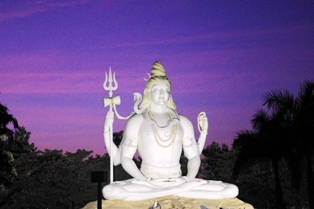His Story/Her Story
A Lovestory from Purana's
In
retrospect storytelling, is an art.
I recall my childhood days when every Friday
we had a kid's union in our home and under my grandfather’s supervision
we had
to narrate a story.
Whoever did it by capturing the interest of the peers,
was
considered the winner and given a chocolate.
The traditional method of
storytelling in India
since Vedic age is through dhwani (sound in rhythm) and
Sruti (words)
for a storyteller the aim was illumination,
not logical conviction,
their ideal, the inspired seer, not the accurate reasoner.
This Indian
tradition has faithfully preserved this account in Kathakali- dance drama.
Kathakali:
The
attractive make-up of the characters, elaborate costumes,
detailed gestures
with well-defined body movements
presented in tune with the anchor playback
music accompanied by complimentary percussion.
Kathakali emerged from
Krishanattam,
life and activities of lord Krishna but stories from Puranas are
also acted.
"Purāṇas are supplementary
explanations of the Vedas
intended for different types of men.
All men are not
equal.
There are men who are conducted by the mode of goodness,
others who are
under the mode of passion and
others who are under the mode of ignorance.
This was
a story from Chandogya Upanishad, which I attended in Munnar-India.
Chandogya means Primary and Upanishad is collection
of vedic text.
The performance is called Chayar Koothu, this was basically
performed inside Hindu temples.
The reason being the stage is not a very
elaborate one,
at one time one or maximum two actors can perform a piece
together.
This also emphasizes natyacharya means dramaturgy,
where skills are required
to perform with mudras (expression) and minimum yet skillful body movement as
space is restricted.
This
small skit can be performed solo but three artists from the Punarjani Kathakali
centre gave the flamboyant performance.
The story is of desire, deception, dereliction
of duty and death.
Now the story:
Yakshagana, Yakhsa means natural spirit,
in coastal karnataka this is depicted
as raw, uncultured,
not very polished character thus is called Rakshasa or the
devil.
So this uncouth, uncultured she devil roams in her paradise,
called
earth which is bountiful with lush green forests,
streaming brooks and birds
flock together but she is all alone.
As to prove her might she has killed all
the men in her region
and thus lusts for attention and passion of a man.
Suddenly
she sees a beautiful, ornamented chariot flying across the forest.
Pursued by curiosity
she follows it
and sees the handsome driver Indra (the lord of devas)
Devas were the bang
opposite of Rakshasa/ Asura.
They were cultured, dignified, dressed well and
above all were fair in complexion.
This she
devil gets enchanted by Indra’s looks,
and she desires to have him. But now she
realizes her draw-back,
how could she present herself to this good-looking,
well dressed man in her unpolished, uncultured, non-manicured and pedicure
form.
So she undergoes
a beauty treatment and transforms herself into an apsara, a beauty.
Now Yakshagana
discards her Rakshasa form,
disguised as an apsara, divine beauty goes to meet
Indra to woo him.
Indra falls in love at first sight.
They
both enjoy a blissful phase but when Yakshagana,
asks Indra to marry her, he
takes a double take and refuses her.
She
becomes dispirited but Indra, the leader of the devas,
tells her of his kingdom’s
rule- where love happens
but Man and woman live together without shouldering
any responsibility
towards the other and the institution called marriage is
very outdated.
Now even the uncultured asura’s of the earth should also adopt
the divine ways and forget marriage.
Yakshagana,
jilted in love, gets angry
and takes her original form of Rakshasa and comes
towards Indra to kill him.
A fight ensues in which finally Indra proves to be
all mighty and kills the Rakshasa.
Moral of the story: A love -story ideally involves two persons
and usually its a private affair.
If one wants to make it public,
the thing called "Marriage" is announced and end of love-story but that's old times.
Modern times: A twisted tale is unfolding in Mumbai.
The Bollywood actor, Shushant Singh Rajput's mysterious demise.
A whose-dunnit coming out with news facts each day on media and social media.
Meantime, a film of his releases and the distribution platform smartly
makes it an open view and gathers multiple eyeballs.
The funny term called "Personalization" comes to play,
which region got more eyeballs, the age group, device,
at a stretch how many minutes viewed, when was the break and why? etc..
A love-story is not a business affair.
A love story still is a private one.
A love story is a Human thing.
The day Media people understand the difference between
"humanization" and "personalization" may be
we will once again be able to read,
view, see a love story where boost behavior rates
and message relevancy will not take precedence over trust and retention.






Comments
Post a Comment